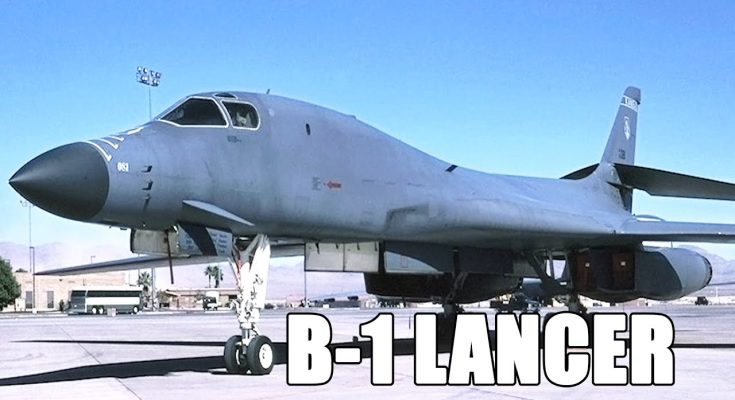The Rockwell B-1 Lancer is one of the most versatile and unique bombers ever designed by the United States, with the ability to fold its wings to achieve greater speeds—a feature that sets it apart from many other aircraft. The B-1 Lancer is a long-range strategic bomber that combines speed, maneuverability, and payload capacity, making it an essential component of the U.S. Air Force’s fleet. Its story is one of technological innovation, strategic shifts, and military adaptation over several decades.
Origins and Development
The development of the B-1 Lancer traces back to the 1960s and early 1970s when the U.S. Air Force sought a new bomber capable of bypassing sophisticated Soviet air defenses. Originally, the B-1 was conceived as a supersonic nuclear bomber, intended to carry large payloads of nuclear weapons deep into enemy territory. The aircraft was designed to be highly maneuverable, capable of flying at low altitudes to avoid radar detection, and was equipped with the ability to penetrate Soviet defenses at high speeds.
In the early 1970s, the U.S. Air Force issued a contract to Rockwell International to develop this next-generation bomber. The B-1A, the first prototype, took its maiden flight in 1974. The B-1A was equipped with swing-wings—wings that could be adjusted during flight to improve both speed and maneuverability. At low speeds, the wings could be swept back for increased aerodynamic efficiency, while at higher speeds, they could be extended for greater lift and stability.
However, despite the promising design, the B-1A faced significant political and budgetary challenges during the Cold War. In the late 1970s, the program was canceled under the administration of President Jimmy Carter due to concerns over cost and the development of newer missile technology. The cancellation left the U.S. with a gap in its long-range bomber capabilities.
The B-1B: A New Era
In the early 1980s, under President Ronald Reagan, the U.S. government revived the B-1 program as a result of shifting defense priorities. The B-1B Lancer, the version that entered production, was designed with a focus on conventional bombing capabilities rather than nuclear payloads, reflecting a strategic shift in military priorities during the 1980s. The B-1B’s design featured several key updates, including more robust engines, improved radar systems, and a new suite of avionics, allowing it to become a versatile platform for both nuclear and conventional missions.
The swing-wing design was one of the most innovative features of the B-1B, allowing the bomber to adapt its aerodynamics depending on the flight phase. At low speeds, the wings can be swept forward to improve lift and stability, particularly during takeoff and landing. When the bomber needs to reach higher speeds, the wings can be extended backward to reduce drag and achieve faster flight characteristics. This flexibility enables the B-1B to fly at speeds up to Mach 1.25 (around 950 miles per hour) at high altitudes, while still maintaining its ability to maneuver at low altitudes.
Combat Performance and Operational History
The B-1B Lancer was deployed during a time of shifting military strategies, and its role quickly evolved. It was designed to perform penetration bombing missions and strike high-value targets deep behind enemy lines, particularly in Soviet territory. However, the end of the Cold War and the dissolution of the Soviet Union shifted its focus to conventional warfare. The B-1B was adapted to drop precision-guided munitions (PGMs) in Operation Desert Storm (1991), where it demonstrated its ability to strike key targets with precision, as well as its versatility as a multi-role bomber.
Throughout the 1990s and 2000s, the B-1B continued to see action in various conflicts, including Operation Iraqi Freedom and Operation Enduring Freedom. Its long range, large payload capacity, and ability to fly at low altitudes to avoid detection made it a critical asset for the U.S. Air Force in conventional bombing roles. The B-1B was also extensively modified during its service life, with upgraded avionics, communication systems, and weaponry, ensuring its continued relevance in the modern era of warfare.
The B-1’s Legacy and Continued Role
Despite being an older aircraft, the B-1 Lancer continues to serve as one of the U.S. Air Force’s primary bombers. Over 100 units were produced, and the B-1B has been upgraded multiple times to meet the needs of modern warfare. Its ability to carry a diverse array of bombs and missiles, including Joint Direct Attack Munitions (JDAMs) and Cruise Missiles, makes it highly adaptable.
Today, the B-1 is part of the U.S. nuclear triad but primarily serves as a conventional bomber capable of delivering a wide range of precision-guided munitions. It remains a symbol of technological innovation and strategic power, as it is one of the few bombers in the world capable of reaching supersonic speeds and carrying such a large payload. The swing-wing feature, which allows it to adjust its wings for optimal flight conditions, continues to be a key design aspect that sets the B-1 apart from other bombers.
Conclusion
The Rockwell B-1 Lancer represents a remarkable chapter in military aviation history. From its early conceptualization as a nuclear bomber to its current role as a powerful conventional strike asset, the B-1 has proven to be one of the most adaptable and reliable aircraft in the U.S. Air Force. The unique ability of the B-1 to fold its wings for speed or maneuverability is just one example of the innovative engineering that has kept it in service for decades. As it continues to evolve, the B-1 Lancer remains a cornerstone of American air power, capable of striking a wide range of targets with precision, flexibility, and speed.



